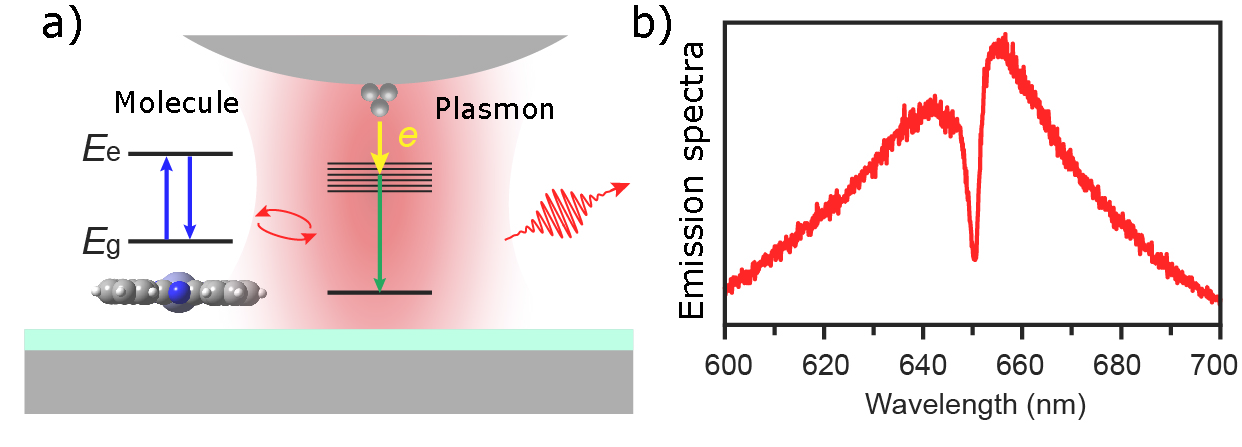COHERENT INTERACTION BETWEEN A SINGLE MOLECULE AND A PLASMONIC CAVITY
Light emission form a single molecular emitter change when the molecule is located close to a plasmonic cavity. Now the spectral features of this light emission can be monitored and controlled with Ångstrom precision in a STM cavity.
When light is confined into ‘hot-spots’ of nanometer size, it interacts very efficiently with single molecules, which allows to measure the molecular properties and manipulate their state. Such light confinement is not possible by conventional means, but it can be achieved by exciting plasmons, collective resonances of the free electrons of metals. By exciting a very small plasmonic hot-spot in the cavity formed between a metallic tip and a substrate, exquisite control with sub-nanometer spatial resolution of the coherent interaction between a plasmonic mode and a single molecule has been demonstrated.
Researchers at the Centro de Física de Materiales and the Donostia International Physics Center in San Sebastian, together with collaborators in the University of Science and Technology of China in Hefei, have studied theoretically and experimentally the optical response of a molecule that is situated near a silver Scanning Tunneling Microscope (STM) tip working at cryogenic temperature. The molecule is separated from a silver substrate by a NaCl monolayer that avoids chemical interactions between the two, with the tunneling current between the tip and the metallic substrate allowing to control and monitor the tip position with subnanometer resolution. Notably, as the system is metallic, a plasmonic mode exists that confines the electromagnetic energy to a small hot-spot at the tip-substrate gap.
If the molecule is deposited directly under the tip, the fluctuations of the tunneling current directly excite the molecular transitions, which then can emit very efficiently due to their coupling with the plasmon. An even more interesting situation occurs when the molecule is displaced slightly out of the plasmonic cavity (Figure a). In this case, the current fluctuations excite the plasmonic resonance, and then the plasmon can excite a molecular transition, which interacts back with the plasmon. This coherent ‘back-and-forth’ interaction between molecule and plasmonic cavity results in very characteristic Fano profiles of the emission (Figure b)
By tracking the changes in the Fano profile as the tip is displaced, it was possible to demonstrate a strong localization of the electromagnetic field to a plasmonic hot-spot of ≈1nm of lateral size and, as a consequence, to control the coherent plasmon-molecule coupling with sub-nanometer resolution. In particular, it was possible to reach very strong values of the molecule-plasmonic cavity coupling strength, enough to accelerate the molecular emission by tens of thousands. Furthermore, this interaction also leads to changes in the energy of the molecular transition due to the so-called photonic Lamb shift. In most systems, this effect is very weak, but the presence of the plasmonic resonance made possible to shift the transition spectrally by as much as ≈1nm (3meV). This work thus advances towards the control of electronic states of individual molecules by coherent coupling with plasmonic modes.

Figure: (a) Scheme of the set-up in the experiments. An electron current between the metallic tip and substrate (depicted by the yellow arrow) excites a plasmonic cavity resonance (represented by the ground state and quasi-continuum at the center of the figure, with the green arrow between them symbolizing plasmonic decay). This plasmon interacts with a two level transition of a molecule (characterized by ground state Eg and excited state Ee) resulting in the emission of a photon. The emission spectrum is shown in (b).



